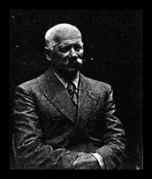Who was Andreas Madsen?

Andreas Madsen, the Danish born pioneer who built his house facing Mount Fitz Roy
The first farmer in the El Chaltén area evolved into a popular author.
Most patagonian pioneers at the turn of the last century were adventurers from poor, densely populated parts of Europe for whom the wild mountains and desolate windswept steppes of this part of the New World offered opportunities for progress that were lacking in their native lands. Some came looking for gold and others were fleeing the long arm of the law, but the majority ended up in Patagonia by chance: upon arrival they learned that the Argentine government would give land to settlers in the south.
Andreas Madsen , whose farm house just outside El Chaltén (Santa Cruz) is open to tourists, came with a surveying expedition and ended up a settler. His books, poems and letters written about his pioneer years offer fascinating insights into life during the early 20th century in the wilderness of the Andean foothills. His book Patagonia Vieja (Old Patagonia) and Cazando Pumas (Hunting Pumas) were such a success in Patagonia that he was invited to give talks in Buenos Aires.
Born in 1881 to an impoverished farming family in western Denmark, Madsen ran away from home and went to sea. He arrived in Buenos Aires aboard the steamer Skanderborg in 1901 when Argentina was in the midst of attempting to work out its frontier with Chile. He landed a job as a cook with the border-marking expedition that Francisco Pascacio Moreno led to Patagonia in the following year. Mount Fitz Roy and the area around Lake Viedma so enamored him that he stayed there and spent the next decade breaking horses, hunting pumas and doing anything else to stay alive.
In 1912 he returned to Denmark to look up his childhood flame Fannt Thomsen, found her and married her. When World War I broke out, the couple immigrated to Patagonia for good. On Estancia Fitz Roy, their farm facing the mountain that so fascinated him, he planted cereal crops and raised several types of barnyard animals in addition to sheep.
Fanny, who had notions of nursing, attended to the region's sick and injured free of charge. With her instructions, Andreas served as midwife during the births of their four children. The named one of their sons Fitz Roy,after the mountain. They used Danish Magazines, which came with the mail two or three times a month from PuertoSanta Cruz, to teach their offspring how to read and write. Fanny kept track of the region's climatic changes for the Weather Bureau.
All the early explorers, mountain climbers and glaciologists who passed through the region were guests at their farm.
When a serious fracture put an end to his puma hunting days, Fanny suggested that he write down his hunting experiences. This he did in English, and the editor of the magazine Argentina Austral in Buenos Aires translated the tales to Spanish. His book Patagonia Vieja was published in 1948; and Cazando Pumas in 1956, after Fanny's death.
Andreas Madsen spent his last years in Bariloche were his children had gone to live, and died there in 1965. He, his wife and children are buried in the family farm outside El Chaltén.
Text in this article has been reproduced from the article "A bit of history, Andreas Madsen", published in the "Patagonia Today" newspaper (year 2, nbr. 7)
|